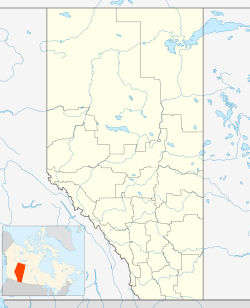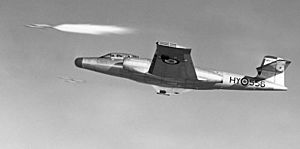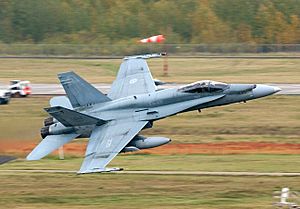CFB Cold Lake facts for kids
Quick facts for kids CFB Cold LakeCold Lake/Group Captain R.W. McNair Airport |
|||||||||||
|---|---|---|---|---|---|---|---|---|---|---|---|
| Base des Forces canadiennes Cold Lake | |||||||||||
| Cold Lake, Alberta in Canada | |||||||||||
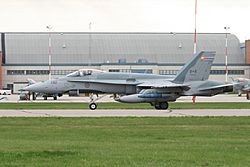
A CF-18 Hornet of the Royal Canadian Air Force at CFB Cold Lake
|
|||||||||||
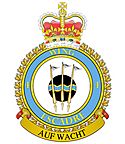 |
|||||||||||
|
Location in Alberta
|
|||||||||||
| Coordinates | 54°24′18″N 110°16′46″W / 54.40500°N 110.27944°W | ||||||||||
| Type | Canadian Forces base | ||||||||||
| Site information | |||||||||||
| Owner | Department of National Defence | ||||||||||
| Operator | Royal Canadian Air Force | ||||||||||
| Controlled by | 1 Canadian Air Division | ||||||||||
| Condition | Operational | ||||||||||
| Site history | |||||||||||
| Built | 1952 – 1954 | ||||||||||
| In use | 1954 – present | ||||||||||
| Events | Exercise Maple Flag | ||||||||||
| Garrison information | |||||||||||
| Current commander |
Colonel Mark Hickey, MSM, CD | ||||||||||
| Garrison | 4 Wing | ||||||||||
| Airfield information | |||||||||||
| Identifiers | IATA: YOD, ICAO: CYOD, WMO: 711200 | ||||||||||
| Elevation | 541 metres (1,775 ft) AMSL | ||||||||||
|
|||||||||||
Canadian Forces Base Cold Lake, often called CFB Cold Lake, is a military base in Cold Lake, Alberta, Canada. It's also known as Cold Lake/Group Captain R.W. McNair Airport.
This base is run by the Royal Canadian Air Force (RCAF). It's located about 35 kilometres (22 miles) south of the Cold Lake Air Weapons Range (CLAWR). This range is a huge area where fighter pilots from CFB Cold Lake practice their skills. CFB Cold Lake is one of only two bases in Canada that has the CF-18 Hornet fighter jet. The main RCAF group at the base is called 4 Wing, or 4 Wing Cold Lake.
In the past, regular flights for civilians used to operate from the base. However, these flights stopped in June 2011. Now, civilian planes usually go to the Cold Lake Regional Airport. The base is named after Robert Wendell "Buck" McNair, a famous pilot from World War II. It's one of only three military airports in Canada named after a person.
The airport is an airport of entry, meaning it can handle international flights. However, only military aircraft and personnel are allowed to use it for international travel.
Contents
History of CFB Cold Lake
Building the Base
Construction of what was then called RCAF Station Cold Lake started in 1952. This was during the Cold War, a time of tension between different countries. The RCAF chose this spot in Alberta to be Canada's main training base for air weapons. They picked this area because it didn't have many people, was easy to get to, had good weather, and suitable land for training. Even though they tried to avoid First Nations reserves, the chosen area included traditional lands. The First Nations groups affected were later given payment.
Military staff arrived at Cold Lake on March 31, 1954, and the base officially began operations that day. In 1955, the Canadian government made an agreement with Saskatchewan and Alberta. This agreement allowed them to use a large area of land, about 180 km by 65 km (112 mi by 40 mi), which became the CLAWR. This huge training area is the main reason why the base is located there.
Training and Aircraft
The CLAWR is similar to the United States Air Force's Nellis Air Force Range but offers a different training environment. It has thick boreal forests and many lakes, which are more like the landscapes in Europe. The range has over 640 real targets and 100 realistic training areas. These include fake airports with runways and buildings, as well as pretend military equipment like tanks and missile sites.
In the 1950s and early 1960s, the base trained crews for the CF-100 Canuck jet. From 1962, the CF-104 Starfighter arrived, and the base started training pilots for Canada's role in NATO in West Germany. This continued until the CF-18 Hornet arrived in 1982. Since then, CFB Cold Lake has been the main training center for the CF-18.
On February 1, 1968, the RCAF joined with the Royal Canadian Navy and Canadian Army to form the unified Canadian Forces. RCAF Station Cold Lake then became CFB Cold Lake.
Missile Testing and Modernization
In the 1980s, CFB Cold Lake became well-known internationally. The CLAWR was used for testing new AGM-86 Tomahawk cruise missiles by the US Air Force. These missiles were launched far away and flew low over the land towards the CLAWR. These tests caused discussions among peace groups and local First Nations people. They were concerned about the new weapons and their impact on international peace. In 1983, a court allowed the tests to go ahead. Canada and the United States then signed an agreement, allowing cruise missile tests to use Canadian airspace.
In 2007, the base was featured in Jetstream, a TV series. It showed eight pilots training to fly a CF-18. In August 2020, new buildings were approved for construction at CFB Cold Lake. These facilities are needed for Canada's future fighter jets, which are expected to arrive starting in 2025.
Current Use of CFB Cold Lake
Base Units and Operations
As of 2023, CFB Cold Lake is home to several important units of 4 Wing:
- 401 Tactical Fighter Squadron (CF-18 Hornet)
- 409 Tactical Fighter Squadron (CF-18 Hornet)
- 410 Tactical Fighter Operational Training Squadron (CF-18 Hornet)
- 417 Combat Support Squadron (CH-146 Griffon helicopter)
- 1 Air Maintenance Squadron
- 42 Radar Squadron
- 10 Field Technical Training Squadron
The base also hosts other groups, including the Aerospace Engineering Testing Establishment. Civilian companies like Top Aces also operate aircraft like Alpha Jets and A-4 Skyhawks for training purposes.
Besides training, the fighter jets from CFB Cold Lake help defend the western part of Canadian airspace. Along with aircraft from CFB Bagotville, they also protect Canada's Arctic region. These aircraft are controlled by NORAD from CFB North Bay and Cheyenne Mountain Operations Center in Colorado.
Cold Lake also hosts flight training for NATO countries. Each year in May–June, CFB Cold Lake hosts Maple Flag. This is a big international air weapons training competition that uses the CLAWR. It's named after the US Air Force's Red Flag exercises. Even NASA and ESA astronauts use Cold Lake for winter survival training!
Cadet Training Centre
The Cold Lake Cadet Training Centre (CLCTC) is located at 4 Wing Cold Lake. It runs every summer from June to August. Its main goal is to provide a safe and challenging summer training program for cadets.
The Senior Leaders Course (SLC) moved to CFB Cold Lake in 1973. Over the years, other courses were added, like the Survival School in 1988. In 1993, a Cadet Service Band program was also added. The CLCTC has about 205 staff members, including cadets, officers, and civilians, from all over Canada.
Since 2024, CLCTC has been running specific courses:
- Introduction to Survival (ITS)
- Survival Instructor (SI)
- Advanced Aviation (AA)
- Aviation Technology & Aerospace (ATA)
4 Wing Brass and Reed Band
CFB Cold Lake has its own band that is part of the 4 Wing of the RCAF. This band was officially started in November 1982. It performs for events at the base and for the city of Cold Lake.
Here are some of the people who have led the band:
- Eric "Rick" Watson (1978–1985)
- Jeff Gaye (1990–2009)
- Cam Martin (2014–2015)
- Jeremy Duggleby (since 2015)
Non-Military Use of the CLAWR
The Cold Lake Air Weapons Range (CLAWR) is also used for non-military activities. Since the 1990s, more and more groups have been using the airspace, land, and resources in and around the range. For example, companies like Canadian Natural Resources and Cenovus Energy use parts of the CLAWR for oil sands projects. These projects use methods like steam injection to extract oil.
Indigenous groups also use the CLAWR for traditional hunting. This is part of an agreement they have with the Department of National Defence.
See also
- Cold Lake Regional Airport
- Cold Lake Air Force Museum
- Improvement District No. 349, a former district that was mostly the Cold Lake Air Weapons Range
- Jetstream (TV series)


